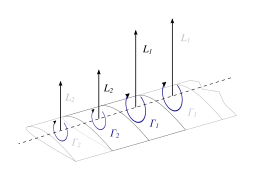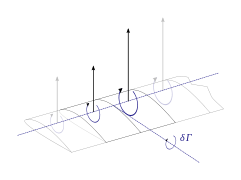Lifting-line theory
The Prandtl lifting-line theory[1] is a mathematical model that predicts lift distribution over a three-dimensional wing based on its geometry. It is also known as the Lanchester–Prandtl wing theory.[2]
The theory was expressed independently[3] by Frederick W. Lanchester in 1907,[4] and by Ludwig Prandtl in 1918–1919[5] after working with Albert Betz and Max Munk.
In this model, the vortex loses strength along the whole wingspan because it is shed as a vortex-sheet from the trailing edge, rather than just at the wing-tips.[6][7]
Introduction


On a three-dimensional, finite wing, lift over each wing segment (local lift per unit span, or ) does not correspond simply to what two-dimensional analysis predicts. Instead, this local amount of lift is strongly affected by the lift generated at neighboring wing sections.
It is difficult to predict analytically the overall amount of lift that a wing of given geometry will generate. The lifting-line theory yields the lift distribution along the span-wise direction, based only on the wing geometry (span-wise distribution of chord, airfoil, and twist) and flow conditions (, , ).
Principle
The lifting-line theory applies the concept of circulation and the Kutta–Joukowski theorem,
so that instead of the lift distribution function, the unknown effectively becomes the distribution of circulation over the span, .
-
The lift distribution over a wing can be modeled with the concept of circulation
-
A vortex is shed downstream for every span-wise change in lift
Modeling the (unknown and sought-after) local lift with the (also unknown) local circulation allows us to account for the influence of one section over its neighbors. In this view, any span-wise change in lift is equivalent to a span-wise change of circulation. According to Helmholtz's theorems, a vortex filament cannot begin or terminate in the air. Any span-wise change in lift can be modeled as the shedding of a vortex filament down the flow, behind the wing.
This shed vortex, whose strength is the derivative of the (unknown) local wing circulation distribution, , influences the flow left and right of the wing section.
This sideways influence (upwash on the outboard, downwash on the inboard) is the key to the lifting-line theory. Now, if the change in lift distribution is known at given lift section, it is possible to predict how that section influences the lift over its neighbors: the vertical induced velocity (upwash or downwash, ) can be quantified using the velocity distribution within a vortex, and related to a change in effective angle of attack over neighboring sections.
In mathematical terms, the local induced change of angle of attack on a given section can be quantified with the integral sum of the downwash induced by every other wing section. In turn, the integral sum of the lift on each downwashed wing section is equal to the (known) total desired amount of lift.
This leads to an integro-differential equation in the form of where is expressed solely in terms of the wing geometry and its own span-wise variation, . The solution to this equation is a function, , that accurately describes the circulation (and therefore lift) distribution over a finite wing of known geometry.
Derivation
(Based on.[8])
Nomenclature:
- is the circulation over the entire wing (m²/s)
- is the 3D lift coefficient (for the entire wing)
- is the aspect ratio
- is the freestream angle of attack (rad)
- is the freestream velocity (m/s)
- is the drag coefficient for induced drag
- is the planform efficiency factor
The following are all functions of the wings span-wise station (i.e. they can all vary along the wing)
- is the 2D lift coefficient (units/m)
- is the 2D circulation at a section (m/s)
- is the chord length of the local section
- is the local change in angle of attack due to geometric twist of the wing
- is zero-lift angle of attack of that section (depends on the airfoil geometry)
- is the 2D lift coefficient slope (units/m⋅rad, and depends on airfoil geometry, see Thin airfoil theory)
- is change in angle of attack due to downwash
- is the local downwash velocity
To derive the model we start with the assumption that the circulation of the wing varies as a function of the spanwise locations. The function assumed is a Fourier function. Firstly, the coordinate for the spanwise location is transformed by , where y is spanwise location, and s is the semi-span of the wing.
and so the circulation is assumed to be:
Since the circulation of a section is related the by the equation:
but since the coefficient of lift is a function of angle of attack:
hence the vortex strength at any particular spanwise station can be given by the equations:
This one equation has two unknowns: the value for and the value for . However, the downwash is purely a function of the circulation only. So we can determine the value in terms of , bring this term across to the left hand side of the equation and solve. The downwash at any given station is a function of the entire shed vortex system. This is determined by integrating the influence of each differential shed vortex over the span of the wing.
Differential element of circulation:
Differential downwash due to the differential element of circulation (acts like half an infinite vortex line):
The integral equation over the span of the wing to determine the downwash at a particular location is:
After appropriate substitutions and integrations we get:
And so the change in angle attack is determined by (assuming small angles):
By substituting equations 8 and 9 into RHS of equation 4 and equation 1 into the LHS of equation 4, we then get:
After rearranging, we get the series of simultaneous equations:
By taking a finite number of terms, equation 11 can be expressed in matrix form and solved for coefficients A. Note the left-hand side of the equation represents each element in the matrix, and the terms on the RHS of equation 11 represent the RHS of the matrix form. Each row in the matrix form represents a different span-wise station, and each column represents a different value for n.
Appropriate choices for are as a linear variation between . Note that this range does not include the values for 0 and , as this leads to a singular matrix, which can't be solved.
Lift and drag from coefficients
The lift can be determined by integrating the circulation terms:
which can be reduced to:
where is the first term of the solution of the simultaneous equations shown above.
The induced drag can be determined from
which can also be reduced to:
where are all the terms of the solution of the simultaneous equations shown above.
Moreover, this expression may be arranged as a function of in the following way :
where
is the span efficiency factor
Symmetric wing
For a symmetric wing, the even terms of the series coefficients are identically equal to 0, and so can be dropped.
Rolling wings
When the aircraft is rolling, an additional term can be added that adds the wing station distance multiplied by the rate of roll to give additional angle of attack change. Equation 3 then becomes:
where
- is the rate of roll in rad/sec,
Note that y can be negative, which introduces non-zero even coefficients in the equation that must be accounted for.
Control deflection
The effect of ailerons can be accounted by simply changing term in Equation 3. For non-symmetric controls such as ailerons the term changes on each side of the wing.
Elliptical wings
For an elliptical wing with no twist, with:
The chord length is given as a function of span location as:
Also,
This yields the famous equation for the elliptic induced drag coefficient:
where
- is the value of the wing span,
- is the position on the wing span, and
- is the chord.
Useful approximations
A useful approximation is that
where
- is the 3D lift coefficient for elliptical circulation distribution,
- is the 2D lift coefficient slope (see Thin Airfoil Theory),
- is the aspect ratio, and
- is the angle of attack in radians.
The theoretical value for is 2. Note that this equation becomes the thin airfoil equation if AR goes to infinity.[10]
As seen above, the lifting-line theory also states an equation for induced drag:.[11][12]
where
- is the drag coefficient for induced drag,
- is the 3D lift coefficient, and
- is the aspect ratio.
- is the planform efficiency factor (equals 1 for elliptical circulation distribution, and usually tabulated for other distributions).
Limitations of the theory
The lifting line theory does not take into account the following:
See also
Notes
- ^ Anderson, John D. (2001), Fundamental of aerodynamics, McGraw-Hill, Boston. ISBN 0-07-237335-0. p360
- ^ Houghton, E. L.; Carpenter, P.W. (2003). Butterworth Heinmann (ed.). Aerodynamics for Engineering Students (5th ed.). ISBN 0-7506-5111-3.
- ^ Kármán, Theodore von (1954). Cornell University Press (reproduced by Dover in 2004) (ed.). Aerodynamics: Selected Topics in the Light of their Historical Development. ISBN 0-486-43485-0.
{{cite book}}: CS1 maint: numeric names: editors list (link) - ^ Lanchester, Frederick W. (1907). Constable (ed.). Aerodynamics.
- ^ Prandtl, Ludwig (1918). Königliche Gesellschaft der Wissenschaften zu Göttingen (ed.). Tragflügeltheorie.
- ^ Abbott, Ira H., and Von Doenhoff, Albert E., Theory of Wing Sections, Section 1.4
- ^ Clancy, L.J., Aerodynamics, Section 8.11
- ^ Sydney University's Aerodynamics for Students (pdf)
- ^ Ref?
- ^ Aerospace Web's explanation of lift coefficient
- ^ Abbott, Ira H., and Von Doenhoff, Albert E., Theory of Wing Sections, Section 1.3
- ^ Clancy, L.J., Aerodynamics, Equation 5.7
References
- Clancy, L.J. (1975), Aerodynamics, Pitman Publishing Limited, London. ISBN 0-273-01120-0
- Abbott, Ira H., and Von Doenhoff, Albert E. (1959), Theory of Wing Sections, Dover Publications Inc., New York. Standard Book Number 486-60586-8















































![{\displaystyle 4sV_{\infty }\sum _{n=1}^{\infty }A_{n}\sin(n\theta )={\frac {1}{2}}V_{\infty }cC_{l_{\alpha }}\left[\alpha _{\infty }+\alpha _{geo}-\alpha _{0}-\sum _{n=1}^{\infty }{\frac {nA_{n}\sin(n\theta )}{\sin(\theta )}}\right]\qquad (10)}](https://wikimedia.org/api/rest_v1/media/math/render/svg/f04bbf405f7fb216add21bfe2e04b7989e40cddb)































